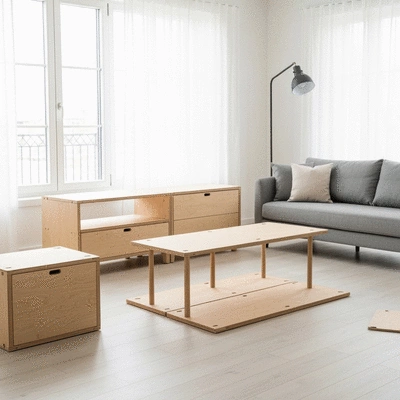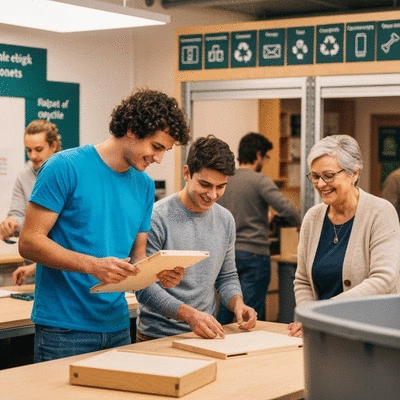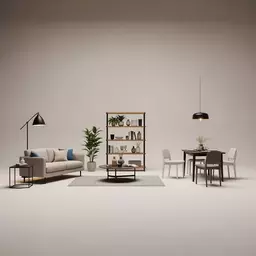Recycle Flatpack Furniture Sustainably

Could your furniture choices make a difference for the planet? Flatpack furniture isn’t just about convenience; it’s a sustainable solution with significant environmental benefits. Let’s explore how choosing this type of furniture can transform your home and contribute positively to the earth.
What You Will Learn
- Flatpack furniture reduces landfill waste and lowers your carbon footprint through efficient packaging and shipping.
- Sustainable materials like bamboo and recycled wood enhance both the quality and eco-friendliness of flatpack products.
- Adopting eco-friendly manufacturing practices leads to reduced energy consumption and waste in furniture production.
- Recycling and repurposing flatpack furniture conserves resources and fosters community engagement.
- Embracing minimalism encourages thoughtful purchasing and contributes to a decluttered, sustainable lifestyle.
Key Pillars of Sustainable Flatpack Furniture
Flatpack furniture offers significant environmental benefits through sustainable materials, eco-friendly production, and end-of-life management. Explore the key areas below. For more insights on how these benefits tie into broader environmental goals, consider reading about flatpack furniture and sustainable living.
Sustainable Materials
- ✓Bamboo: fast-growing, strong, versatile.
- ✓Recycled Wood: repurposes existing materials.
- ✓Non-Toxic Finishes: healthier indoor environment.
Eco-Friendly Production
- ★Renewable energy: reduces carbon footprint.
- ★Waste reduction: minimizes manufacturing waste.
- ★Longevity design: furniture built to last.
Recycling & Repurposing
- ↺Reduced Landfill Waste: extends furniture life.
- ↺Resource Conservation: fewer new materials used.
- ↺Lower Carbon Footprint: less energy-intensive.
Benefits of Minimalism
- ✓Less Consumption: reduces overall waste.
- ✓Improved Well-being: decluttered, peaceful spaces.
- ✓Mindful Choices: encourages thoughtful purchasing.
Understanding Flatpack Furniture: A Sustainable Approach
Flatpack furniture is more than just a convenient solution for home decor—it's also a sustainable choice that can help reduce our environmental footprint. But what exactly is flatpack furniture? Simply put, it's any piece of furniture that comes disassembled in a box, ready for you to put together at home. This method not only saves space during transport but also allows for more efficient packaging and shipping. Isn't that fantastic?

The environmental impact of flatpack furniture is significant. By opting for these products, you contribute to less waste in landfills and a lower carbon footprint associated with shipping heavier, assembled items. It’s a win-win situation for both your home and the planet!
What is Flatpack Furniture and Its Environmental Impact?
Flatpack furniture has gained popularity for several reasons, including its affordability and ease of assembly. However, its environmental impact is perhaps the most compelling reason to consider it as your go-to choice for home improvement. By using less material for packaging and transport, flatpack solutions can help minimize your contribution to waste. To ensure a smooth process, it's always a good idea to have the essential tools for flat-pack furniture on hand before you begin assembly.
- Less energy is used in production and shipping.
- Compact design means more items can fit in a single shipment, reducing transport emissions.
- Flatpack items often use sustainably sourced materials.
By recognizing these benefits, you can make more informed decisions about your furniture purchases. It's about creating a home that's not only stylish but also environmentally conscious.
The Role of Materials: Sustainable Choices in Flatpack Design
At Flatpack Hub, I believe that the materials used in flatpack furniture are crucial for sustainability. Many manufacturers are now choosing eco-friendly materials like bamboo, recycled wood, and non-toxic finishes. This shift not only enhances the quality of the furniture but also aligns with a more sustainable approach to home living.
- Bamboo: A fast-growing, renewable resource that is incredibly strong and versatile.
- Recycled Wood: Reducing waste by repurposing existing materials for new designs.
- Non-Toxic Finishes: Ensuring a healthier indoor environment by avoiding harmful chemicals.
By selecting flatpack furniture made from these materials, you’re not just enhancing your home; you’re also contributing to a healthier planet. And who wouldn’t want that?
Exploring Eco-Friendly Practices in Flatpack Furniture Production
Flatpack furniture production is evolving, with many companies adopting eco-friendly practices that make a tangible difference. These practices include everything from responsible sourcing of materials to implementing energy-efficient manufacturing processes.
- Using renewable energy sources in production.
- Implementing waste reduction strategies during manufacturing.
- Creating furniture that is designed for longevity and end-of-life recyclability.
As I dive deeper into the world of flatpack furniture, I’m constantly amazed by the creativity and responsibility of manufacturers who prioritize sustainability. Supporting these businesses not only helps you build a beautiful home but also fosters a community that values our planet.
Pro Tip
When selecting flatpack furniture, consider brands that prioritize sustainability in their production processes. Look for certifications such as FSC (Forest Stewardship Council) for wood products or those that use recycled materials. This not only ensures that you are making an eco-friendly choice but also supports companies committed to protecting our planet.
Embracing Sustainable Practices in Furniture Management
As we navigate through the world of furniture, it's essential to recognize the impact our choices can have on the environment. By embracing sustainable practices, we can significantly reduce waste and contribute to a healthier planet. At Flatpack Hub, I am passionate about empowering you with the knowledge to make eco-conscious decisions about your flatpack furniture!
Recycling and repurposing flatpack furniture not only helps to minimize landfill waste but also offers numerous environmental benefits. For instance, when we recycle, we conserve natural resources and reduce pollution generated from manufacturing new items. Let's explore some of the environmental benefits of recycling and repurposing your flatpack pieces:
- Reduced Landfill Waste: Keeping furniture out of landfills decreases the overall waste we produce.
- Conservation of Resources: Recycling furniture means fewer trees cut down and less energy used in manufacturing new products.
- Lower Carbon Footprint: By opting for second-hand or repurposed furniture, we contribute to reduced greenhouse gas emissions.
Understanding these benefits can motivate us to incorporate sustainable practices in our daily lives. Not only do we help the environment, but we also create stylish and unique living spaces that reflect our values!

Evaluating the Impact: Environmental Benefits of Recycling and Repurposing
When evaluating the impact of recycling and repurposing flatpack furniture, consider how each action contributes to a more sustainable future. By choosing to recycle or repurpose, you are actively participating in a cycle that promotes eco-friendliness. Here are some critical aspects to contemplate:
- Resource Efficiency: By recycling, we use existing materials rather than depleting new resources.
- Waste Reduction: Repurposing extends the life of your furniture, minimizing waste.
- Community Benefits: Donating or sharing furniture fosters community engagement and support.
These small steps can lead to significant changes in our environment, proving that every action counts. So, let’s make a conscious choice to recycle and repurpose!
Adopting a Minimalist Lifestyle: Benefits for Sustainable Living
Embracing a minimalist lifestyle goes hand in hand with sustainable living. It encourages us to be intentional with our purchases and to prioritize quality over quantity. By reducing clutter and focusing on what truly matters, we can enhance our living spaces while also benefiting the environment. Let’s look at some reasons why minimalism can be a great step toward sustainability:
- Less Consumption: With fewer items to manage, we naturally consume less and waste less.
- Improved Well-being: A decluttered space can reduce stress and create a more peaceful atmosphere.
- Encouragement of Mindful Choices: Minimalism encourages thoughtful purchasing decisions, leading to better investments in quality products.
By adopting a minimalist approach, we not only simplify our lives but also contribute to a more sustainable future. It’s a win-win!
Frequently Asked Questions
- What are the main environmental benefits of flatpack furniture?
- Flatpack furniture reduces landfill waste, lowers carbon footprints through efficient packaging and shipping, and often utilizes sustainable materials and eco-friendly production methods.
- What sustainable materials are commonly used in flatpack furniture?
- Common sustainable materials include bamboo (fast-growing and strong), recycled wood (repurposes existing materials), and non-toxic finishes for a healthier indoor environment.
- How do eco-friendly production practices contribute to sustainability?
- Eco-friendly production involves using renewable energy sources, implementing waste reduction strategies during manufacturing, and designing furniture for longevity and recyclability.
- Why is recycling and repurposing flatpack furniture important?
- Recycling and repurposing flatpack furniture conserves natural resources, reduces landfill waste, and lowers carbon emissions by extending the life of products and decreasing the need for new manufacturing.
- How does minimalism relate to sustainable living with flatpack furniture?
- Adopting a minimalist lifestyle encourages less consumption, thoughtful purchasing, and improved well-being by reducing clutter. This aligns with the sustainable principles of flatpack furniture by promoting quality over quantity and reducing overall waste.
Taking Action: Your Next Steps Towards Eco-Conscious Furniture Management
Now that we’ve explored the benefits of sustainable practices, let’s talk about how you can take action in your own home. At Flatpack Hub, I believe that every step counts, and your contributions to eco-conscious furniture management can make a difference. Here are some practical steps you can take:
Resources for Further Learning and Community Engagement
To fully embrace sustainable furniture management, it’s essential to educate yourself and connect with your community. Here are some resources to help you get started:
- Local Workshops: Look for workshops that focus on upcycling and sustainable living.
- Online Courses: There are numerous online platforms offering courses on eco-friendly practices.
- Community Groups: Join local community groups dedicated to sustainability and recycling efforts.
Engaging with these resources can provide you with the tools and support you need to make a positive impact in your community!
Join the Movement: Share Your Repurposing Success Stories
Sharing your repurposing success stories is a fantastic way to inspire others! Whether it’s a creative upcycling project or a simple donation to a local charity, your actions can motivate friends and family to join the movement toward sustainable living. You can share your stories through social media or community events—let's spread the word! And if you're looking for practical advice, check out our guide on flat-pack furniture assembly tips to get started on your next project.
Exploring Eco-Friendly Crafts for Home Decor
Lastly, why not explore some eco-friendly crafts to enhance your home decor? Upcycling offers a creative outlet that can turn old furniture into beautiful new pieces. Some ideas include:
- Transforming Old Chairs: Reupholster or paint to give them a fresh look.
- Creating Unique Shelves: Use old wooden pallets for stylish storage solutions.
- Making Decorative Art: Repurpose old frames into wall art or photo displays.
These crafts not only beautify your space but also promote sustainable practices, showcasing your commitment to the environment!
Recap of Key Points
Here is a quick recap of the important points discussed in the article:
- Sustainability of Flatpack Furniture: Opting for flatpack furniture reduces waste and lowers your carbon footprint.
- Materials Matter: Choose eco-friendly materials like bamboo, recycled wood, and non-toxic finishes for a healthier home environment.
- Eco-Friendly Production Practices: Support companies that use renewable energy and implement waste reduction strategies in their manufacturing processes.
- Benefits of Recycling and Repurposing: Recycling conserves resources, reduces landfill waste, and lowers carbon emissions.
- Adopt Minimalism: Embracing a minimalist lifestyle promotes less consumption and encourages mindful purchasing.
- Engagement and Community: Participate in local workshops and community groups to enhance your understanding and commitment to sustainability.








